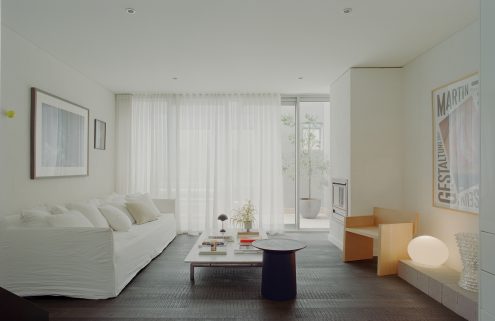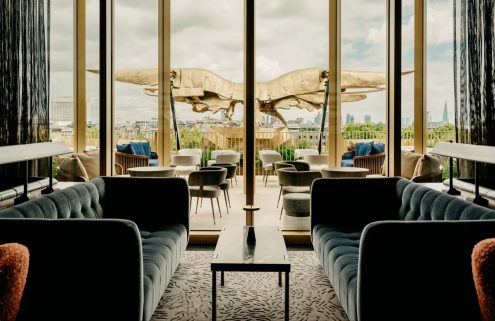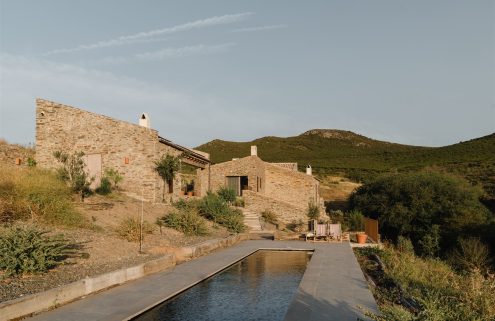Spanish maverick Ricardo Bofill has passed away at the age of 82, leaving an indelible mark on the world thanks to more than 1,000 projects. His buildings, including iconic landmarks such as Walden 7, have become photographic pilgrimage spots that live as large on camera as they do in real life.
Fans of the architect, and his practice Taller de Arquitectura (RBTA), was at the forefront of urban design for more than 50 years, with his thumbprint scattered across 40 countries worldwide.
In a statement from his firm, released on 14 January 2022, colleagues praised Bofill’s ability to ‘question the mainstream thinking in architecture. [His works] ranges a style expression, connected to the context, featuring a strong dose of innovation and risk.’
Here are 9 of his most celebrated buildings that capture his spirit and unique expression.
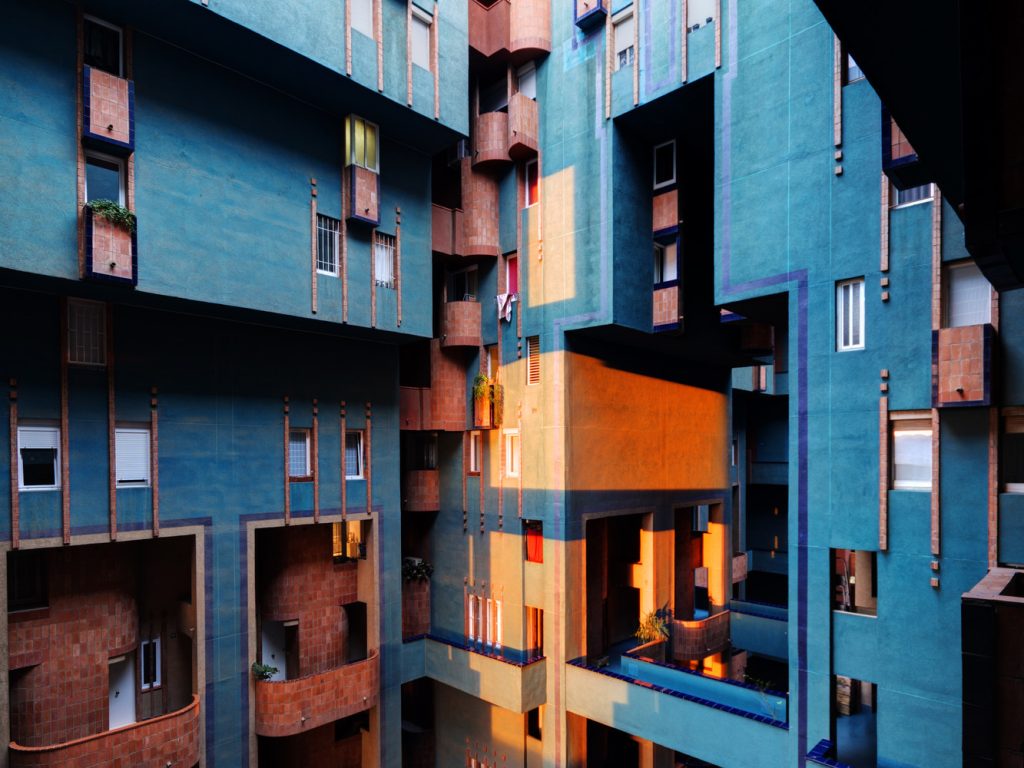
Walden 7 (1975)
Colour is king at Bofill’s Walden 7 complex, which embodies his ideas around the importance of light and outdoor space. The apartment complex is on the same lot as La Fabrica, on the outskirts of Barcelona, and has a bright red exterior reminiscent of a fortress with angular parapets, thanks to its irregular modular grid.
The habitation comprises 14-storey towers arranged around five brightly coloured courtyards – aquamarine, yellow and violet – and each apartment has views of these internal spaces and out beyond the site. Balconies and suspended walkways add to the labyrinthine aesthetic.
Photography: Ricardo Bofill

Walden 7 (1975)
Colour is king at Bofill’s Walden 7 complex, which embodies his ideas around the importance of light and outdoor space. The apartment complex is on the same lot as La Fabrica, on the outskirts of Barcelona, and has a bright red exterior reminiscent of a fortress with angular parapets, thanks to its irregular modular grid.
The habitation comprises 14-storey towers arranged around five brightly coloured courtyards – aquamarine, yellow and violet – and each apartment has views of these internal spaces and out beyond the site. Balconies and suspended walkways add to the labyrinthine aesthetic.
Photography: Ricardo Bofill

Walden 7 (1975)
Colour is king at Bofill’s Walden 7 complex, which embodies his ideas around the importance of light and outdoor space. The apartment complex is on the same lot as La Fabrica, on the outskirts of Barcelona, and has a bright red exterior reminiscent of a fortress with angular parapets, thanks to its irregular modular grid.
The habitation comprises 14-storey towers arranged around five brightly coloured courtyards – aquamarine, yellow and violet – and each apartment has views of these internal spaces and out beyond the site. Balconies and suspended walkways add to the labyrinthine aesthetic.
Photography: Ricardo Bofill
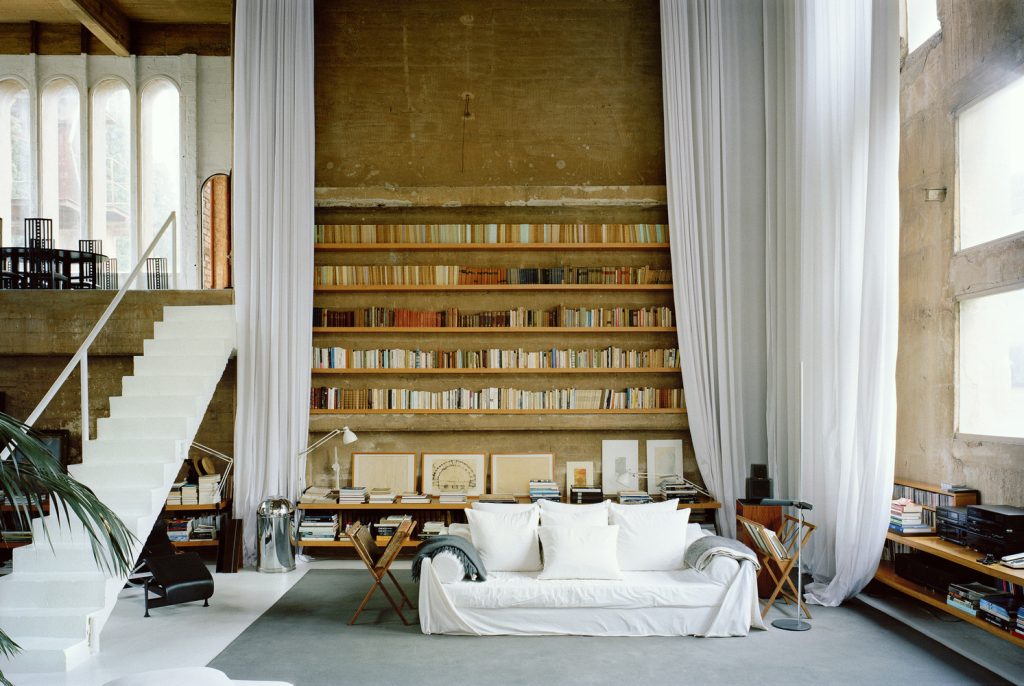
La Fabrica cement factory (1975-present)
Bofill was an early pioneer of ‘adaptive reuse’ and La Fabrica is still held up as one of its greatest examples, more than 50 years on from the project’s development. The architect took a defunct, inter-war cement factory and refurbished it into a private home, with towering concrete volumes, and a studio for his practice, embracing his love of surrealism in the process.
Its success is as much in Bofill’s retention and respect of the original fabric of the building as it is in his minimalist interventions; he removed ceilings and walls and opened volumes up to the sky while retaining silos in their towering forms. Stairs lead to nowhere, while overhanging volumes have post-apocalyptic surrealism to them, heightened by expansive landscaping that sees roofs turned into gardens and the grounds ‘reclaimed’ by nature as a verdant wonderland. Interiors meanwhile are honest and raw thanks to exposed beams, concrete and colossal funnels, and rows of arch windows tap into the building’s pre-history.
Photography: Ricardo Bofill

La Fabrica cement factory (1975-present)
Bofill was an early pioneer of ‘adaptive reuse’ and La Fabrica is still held up as one of its greatest examples, more than 50 years on from the project’s development. The architect took a defunct, inter-war cement factory and refurbished it into a private home, with towering concrete volumes, and a studio for his practice, embracing his love of surrealism in the process.
Its success is as much in Bofill’s retention and respect of the original fabric of the building as it is in his minimalist interventions; he removed ceilings and walls and opened volumes up to the sky while retaining silos in their towering forms. Stairs lead to nowhere, while overhanging volumes have post-apocalyptic surrealism to them, heightened by expansive landscaping that sees roofs turned into gardens and the grounds ‘reclaimed’ by nature as a verdant wonderland. Interiors meanwhile are honest and raw thanks to exposed beams, concrete and colossal funnels, and rows of arch windows tap into the building’s pre-history.
Photography: Ricardo Bofill

La Fabrica cement factory (1975-present)
Bofill was an early pioneer of ‘adaptive reuse’ and La Fabrica is still held up as one of its greatest examples, more than 50 years on from the project’s development. The architect took a defunct, inter-war cement factory and refurbished it into a private home, with towering concrete volumes, and a studio for his practice, embracing his love of surrealism in the process.
Its success is as much in Bofill’s retention and respect of the original fabric of the building as it is in his minimalist interventions; he removed ceilings and walls and opened volumes up to the sky while retaining silos in their towering forms. Stairs lead to nowhere, while overhanging volumes have post-apocalyptic surrealism to them, heightened by expansive landscaping that sees roofs turned into gardens and the grounds ‘reclaimed’ by nature as a verdant wonderland. Interiors meanwhile are honest and raw thanks to exposed beams, concrete and colossal funnels, and rows of arch windows tap into the building’s pre-history.
Photography: Ricardo Bofill

Kafka’s Castle (1968)
Sitting on a hill overlooking the bay of Sitges, Kafka’s Castle is an experimental apartment complex that pays homage to the ideas of the Archigram movement, i.e. experimental geometric forms and reimagining the role of the castle from fortress to living space and allowing circulation to shape design.
The result is a 90-apartment building, whose clusters of minimalist apartment ‘cubes’ are organised around vertical circulation. Conceived as Corbusian ‘unités d’habitation’ the small apartments have flexible partitions, such as shifting mirrors and open kitchens, to allow them to adapt per the user’s need, despite their small size.
Meanwhile, the building’s imposing facade (almost black at first glance) is very nuanced, with a range of shades drawn from the sky.
Photography: Ricardo Bofill

Kafka’s Castle (1968)
Sitting on a hill overlooking the bay of Sitges, Kafka’s Castle is an experimental apartment complex that pays homage to the ideas of the Archigram movement, i.e. experimental geometric forms and reimagining the role of the castle from fortress to living space and allowing circulation to shape design.
The result is a 90-apartment building, whose clusters of minimalist apartment ‘cubes’ are organised around vertical circulation. Conceived as Corbusian ‘unités d’habitation’ the small apartments have flexible partitions, such as shifting mirrors and open kitchens, to allow them to adapt per the user’s need, despite their small size.
Meanwhile, the building’s imposing facade (almost black at first glance) is very nuanced, with a range of shades drawn from the sky.
Photography: Ricardo Bofill

Kafka’s Castle (1968)
Sitting on a hill overlooking the bay of Sitges, Kafka’s Castle is an experimental apartment complex that pays homage to the ideas of the Archigram movement, i.e. experimental geometric forms and reimagining the role of the castle from fortress to living space and allowing circulation to shape design.
The result is a 90-apartment building, whose clusters of minimalist apartment ‘cubes’ are organised around vertical circulation. Conceived as Corbusian ‘unités d’habitation’ the small apartments have flexible partitions, such as shifting mirrors and open kitchens, to allow them to adapt per the user’s need, despite their small size.
Meanwhile, the building’s imposing facade (almost black at first glance) is very nuanced, with a range of shades drawn from the sky.
Photography: Ricardo Bofill

Les Espaces d’Abraxas, Paris (1982)
Used in films such as The Hunger Games, Les Espaces d’Abraxes in Paris’ Noisy-le-Grand has become a go-to for location scouts seeking a sci-fi vibe, thanks to its horseshoe layout, arranged around a grassy plaza that doubles as an amphitheatre. The postmodern structure was built in 1982 and rises to 19 storeys, with apartments peeking onto the central space and arranged in slender volumes that are like giant classical columns.
Photography: Ricardo Bofill

Les Espaces d’Abraxas, Paris (1982)
Used in films such as The Hunger Games, Les Espaces d’Abraxes in Paris’ Noisy-le-Grand has become a go-to for location scouts seeking a sci-fi vibe, thanks to its horseshoe layout, arranged around a grassy plaza that doubles as an amphitheatre. The postmodern structure was built in 1982 and rises to 19 storeys, with apartments peeking onto the central space and arranged in slender volumes that are like giant classical columns.
Photography: Ricardo Bofill

Les Espaces d’Abraxas, Paris (1982)
Used in films such as The Hunger Games, Les Espaces d’Abraxes in Paris’ Noisy-le-Grand has become a go-to for location scouts seeking a sci-fi vibe, thanks to its horseshoe layout, arranged around a grassy plaza that doubles as an amphitheatre. The postmodern structure was built in 1982 and rises to 19 storeys, with apartments peeking onto the central space and arranged in slender volumes that are like giant classical columns.
Photography: Ricardo Bofill

Meritxell Sanctuary (1978)
The most important religious temple in Andorra was destroyed by fire in 1972, leaving only the blackened ruins of the apse, vaulting over the altar, and a latter-day bell tower. Rather than replace like-for-like, Bofill went back to the principles of Romanqesue architecture – common to the region – and its sacred geometries, reinterpreting them via modern building techniques.
The roman arch is integral to his design, with the viaduct bridge and sanctuary both composed of arches. A concave, sunken amphitheatre at the heart of the complex is a gathering place, while other elements include oversized steps, a bridge over the nearby road, climbing towers and an esplanade.
Photography: Ricardo Bofill

Meritxell Sanctuary (1978)
The most important religious temple in Andorra was destroyed by fire in 1972, leaving only the blackened ruins of the apse, vaulting over the altar, and a latter-day bell tower. Rather than replace like-for-like, Bofill went back to the principles of Romanqesue architecture – common to the region – and its sacred geometries, reinterpreting them via modern building techniques.
The roman arch is integral to his design, with the viaduct bridge and sanctuary both composed of arches. A concave, sunken amphitheatre at the heart of the complex is a gathering place, while other elements include oversized steps, a bridge over the nearby road, climbing towers and an esplanade.
Photography: Ricardo Bofill
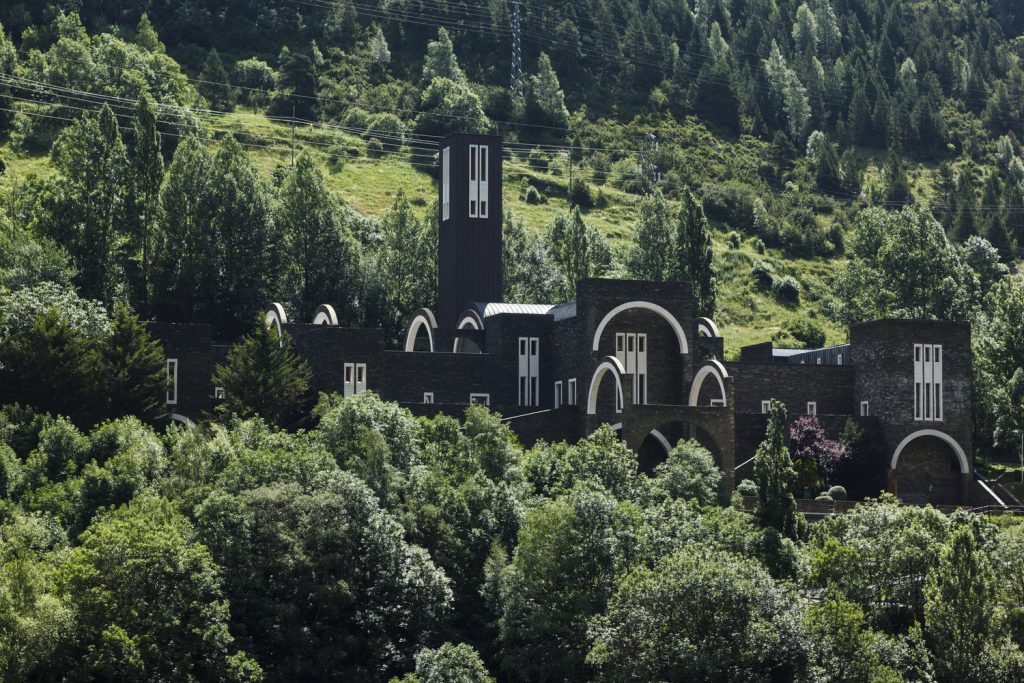
Meritxell Sanctuary (1978)
The most important religious temple in Andorra was destroyed by fire in 1972, leaving only the blackened ruins of the apse, vaulting over the altar, and a latter-day bell tower. Rather than replace like-for-like, Bofill went back to the principles of Romanqesue architecture – common to the region – and its sacred geometries, reinterpreting them via modern building techniques.
The roman arch is integral to his design, with the viaduct bridge and sanctuary both composed of arches. A concave, sunken amphitheatre at the heart of the complex is a gathering place, while other elements include oversized steps, a bridge over the nearby road, climbing towers and an esplanade.
Photography: Ricardo Bofill

La Muralla Roja (1968)
Inspired by the Moorish architecture of North Africa, La Muralla Roja or the Red Wall was completed in La Manzanera in 1973 in a postmodern, constructivist style and is among the most photographed buildings in the world. Its angular geometric forms take inspiration from adobe towers along the coast of Morocco and Tunisia and the complex is Bofill’s spin on the traditional kasbahs or citadels of history.
Along with his customary consideration of the square and public gathering space, the apartments in the complex are connected via walkways, rooftop patios and a pool, and have a labyrinth-like feel similar to his other apartment buildings from the 1960s-70s. La Muralla Roja’s silhouette mirrors the ragged edges of the cliffs in the distance, and it has a similarly imposing fortress appearance that is playfully inverted by Bofill’s use of bright colours.
Photography: Ricardo Bofill

La Muralla Roja (1968)
Inspired by the Moorish architecture of North Africa, La Muralla Roja or the Red Wall was completed in La Manzanera in 1973 in a postmodern, constructivist style and is among the most photographed buildings in the world. Its angular geometric forms take inspiration from adobe towers along the coast of Morocco and Tunisia and the complex is Bofill’s spin on the traditional kasbahs or citadels of history.
Along with his customary consideration of the square and public gathering space, the apartments in the complex are connected via walkways, rooftop patios and a pool, and have a labyrinth-like feel similar to his other apartment buildings from the 1960s-70s. La Muralla Roja’s silhouette mirrors the ragged edges of the cliffs in the distance, and it has a similarly imposing fortress appearance that is playfully inverted by Bofill’s use of bright colours.
Photography: Ricardo Bofill

La Muralla Roja (1968)
Inspired by the Moorish architecture of North Africa, La Muralla Roja or the Red Wall was completed in La Manzanera in 1973 in a postmodern, constructivist style and is among the most photographed buildings in the world. Its angular geometric forms take inspiration from adobe towers along the coast of Morocco and Tunisia and the complex is Bofill’s spin on the traditional kasbahs or citadels of history.
Along with his customary consideration of the square and public gathering space, the apartments in the complex are connected via walkways, rooftop patios and a pool, and have a labyrinth-like feel similar to his other apartment buildings from the 1960s-70s. La Muralla Roja’s silhouette mirrors the ragged edges of the cliffs in the distance, and it has a similarly imposing fortress appearance that is playfully inverted by Bofill’s use of bright colours.
Photography: Ricardo Bofill

Emporda family house, Girona (1973)
In 1973, Bofill completed the Emporda Bofill family home in Girona for his parents, building on the ruins of an old country home. Distilling some of the principles of his apartment complex designs, the home is organised around a bright red courtyard with a pool and geometric arches that frame views of the landscape.
Photography: Ricardo Bofill

Emporda family house, Girona (1973)
In 1973, Bofill completed the Emporda Bofill family home in Girona for his parents, building on the ruins of an old country home. Distilling some of the principles of his apartment complex designs, the home is organised around a bright red courtyard with a pool and geometric arches that frame views of the landscape.
Photography: Ricardo Bofill

Emporda family house, Girona (1973)
In 1973, Bofill completed the Emporda Bofill family home in Girona for his parents, building on the ruins of an old country home. Distilling some of the principles of his apartment complex designs, the home is organised around a bright red courtyard with a pool and geometric arches that frame views of the landscape.
Photography: Ricardo Bofill

Plexus La Manzanera (1966)
In 1966, Bofill’s Plexus Condominiums were among the first projects to be built in the Spanish tourist development La Manzanera, adjacent to the town of Calpe in Alicante. While new, the miniature village had to feel as though it belonged to the Spanish region, and Bofill took his cues from the hilly natural setting, implementing stone building techniques and terraces that are familiar to the Mediterranean coast. The use of vernacular motifs such as shuttered windows, terracotta tiled roofs and arcades adds to the sense of local geography, with the development’s context (among the first developments of its kind) setting a high benchmark for projects to follow across the easter seaboard.
Photography: Ricardo Bofill

Plexus La Manzanera (1966)
In 1966, Bofill’s Plexus Condominiums were among the first projects to be built in the Spanish tourist development La Manzanera, adjacent to the town of Calpe in Alicante. While new, the miniature village had to feel as though it belonged to the Spanish region, and Bofill took his cues from the hilly natural setting, implementing stone building techniques and terraces that are familiar to the Mediterranean coast. The use of vernacular motifs such as shuttered windows, terracotta tiled roofs and arcades adds to the sense of local geography, with the development’s context (among the first developments of its kind) setting a high benchmark for projects to follow across the easter seaboard.
Photography: Ricardo Bofill

Université Mohammed VI Polytechnique, Benguerir (2011)
Narrow streets, public squares and a central axis underpin Bofill’s master plan for the 55 hectares Campus for Mohammed VI Polytechnic University in Benguerir, 50 miles north of Marrakech. Bofill’s ideas around ‘clusters’, geometries and North African architectural typography come into play too while the height limit of 21 metres on buildings maintains the sense of intimacy and connectivity across the complex.
Photography: Gregori Civera, Lluis Carbonell

Université Mohammed VI Polytechnique, Benguerir (2011)
Narrow streets, public squares and a central axis underpin Bofill’s master plan for the 55 hectares Campus for Mohammed VI Polytechnic University in Benguerir, 50 miles north of Marrakech. Bofill’s ideas around ‘clusters’, geometries and North African architectural typography come into play too while the height limit of 21 metres on buildings maintains the sense of intimacy and connectivity across the complex.
Photography: Gregori Civera, Lluis Carbonell

Université Mohammed VI Polytechnique, Benguerir (2011)
Narrow streets, public squares and a central axis underpin Bofill’s master plan for the 55 hectares Campus for Mohammed VI Polytechnic University in Benguerir, 50 miles north of Marrakech. Bofill’s ideas around ‘clusters’, geometries and North African architectural typography come into play too while the height limit of 21 metres on buildings maintains the sense of intimacy and connectivity across the complex.
Photography: Gregori Civera, Lluis Carbonell

A portrait of Ricardo Bofill.
Photography: Gregori Civera / Pati Nuñez Agency

